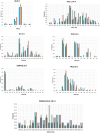Plasmodium falciparum genetic diversity and multiplicity of infection among asymptomatic and symptomatic malaria-infected individuals in Uganda
- PMID: 39543779
- PMCID: PMC11562702
- DOI: 10.1186/s41182-024-00656-7
Plasmodium falciparum genetic diversity and multiplicity of infection among asymptomatic and symptomatic malaria-infected individuals in Uganda
Abstract
Background: Plasmodium falciparum (P. falciparum) remains a significant public health challenge globally, especially in sub-Saharan Africa (SSA), where it accounts for 99% of all malaria infections. The outcomes of P. falciparum infection vary, ranging from asymptomatic to severe, and are associated with factors such as host immunity, parasite genetic diversity, and multiplicity of infection (MOI). Using seven neutral microsatellite markers, the current study investigated P. falciparum genetic diversity and MOI in both asymptomatic and symptomatic malaria individuals in Uganda.
Methods: This cross-sectional study analyzed 225 P. falciparum isolates from both asymptomatic and symptomatic malaria patients, ranging in age from 6 months to ≥ 18 years. P. falciparum genetic diversity, MOI, and multi-locus linkage disequilibrium (LD) were assessed through genotyping of seven neutral microsatellite markers: Poly-α, TA1, TA109, PfPK2, 2490, C2M34-313, and C3M69-383. Genetic data analysis was performed using appropriate genetic analysis software.
Results: P. falciparum infections exhibited high genetic diversity in both asymptomatic and symptomatic individuals. The mean expected heterozygosity (He) ranged from 0.79 in symptomatic uncomplicated malaria cases to 0.81 in asymptomatic individuals. There was no significant difference (p = 0.33) in MOI between individuals with asymptomatic and symptomatic infections, with the mean MOI ranging from 1.92 in symptomatic complicated cases to 2.10 in asymptomatic individuals. Polyclonal infections were prevalent, varying from 58.5% in symptomatic complicated malaria to 63% in symptomatic uncomplicated malaria cases. A significant linkage disequilibrium (LD) was observed between asymptomatic and symptomatic uncomplicated/complicated infections (p < 0.01). Genetic differentiation was low, with FST values ranging from 0.0034 to 0.0105 among P. falciparum parasite populations in asymptomatic and symptomatic uncomplicated/complicated infections.
Conclusion: There is a high level of P. falciparum genetic diversity and MOI among both symptomatic and asymptomatic individuals in Uganda. Asymptomatic carriers harbor a diverse range of parasites, which poses challenges for malaria control and necessitates targeted interventions to develop effective strategies.
Keywords: P. falciparum; Genetic diversity; Malaria; Multiplicity of infection; Uganda.
© 2024. The Author(s).
Conflict of interest statement
Figures

References
-
- WHO. World malaria report 2022. Geneva: World Health Organization; 2022.
-
- Bendixen M, Msangeni H, Pedersen B, Shayo D, Bedker R. Diversity of Plasmodium falciparum populations and complexity of infections in relation to transmission intensity and host age: a study from the Usambara Mountains, Tanzania. Trans R Soc Trop Med Hyg. 2001;95(2):143–8. - PubMed
Grants and funding
LinkOut - more resources
Full Text Sources
Research Materials
Miscellaneous
